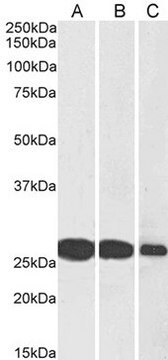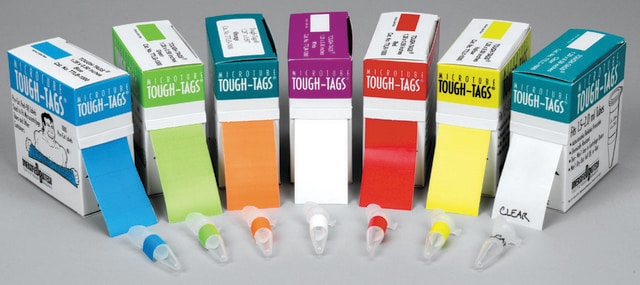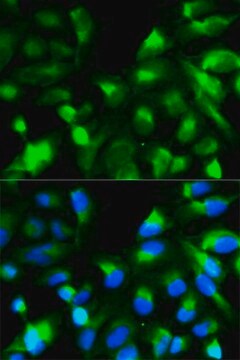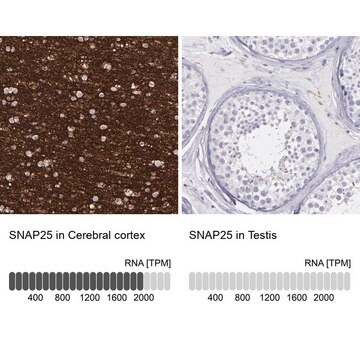詳細
We are committed to bringing you greener alternative products, which adhere to one or more of The 12 Principles of Green Chemistry.This antibody is Preservative-free, produced without the harm or sacrifice of animals and exceptionally stable to allow for ambient shipping and storage if needed and thus aligns with "Waste Prevention", "Designing Safer Chemicals" and "Design for Energy Efficiency".
Click here for more information.
ZooMAb
® antibodies represent an entirely new generation of recombinant monoclonal antibodies.
Each ZooMAb
® antibody is manufactured using our proprietary recombinant expression system, purified to homogeneity, and precisely dispensed to produce robust and highly reproducible lot-to-lot consistency. Only top-performing clones are released for use by researchers. Each antibody is validated for high specificity and affinity across multiple applications, including its most commonly used application. ZooMAb
® antibodies are reliably available and ready to ship when you need them.
Learn more about ZooMAb here.特異性
Clone 1J9 is a ZooMAb® rabbit recombinant monoclonal antibody that specifically detects Synaptosomal-associated protein 25 (SNAP-25). It targets an epitope within 17 amino acids from the internal region.
免疫原
KLH-conjugated linear peptide corresponding to 17 amino acids from the internal region of human Synaptosomal-associated protein 25 (SNAP-25).
アプリケーション
Quality Control Testing
Evaluated by Western Blotting in Mouse brain tissue lysate.
Western Blotting Analysis: A 1:1,000 dilution of this antibody detected SNAP-25 in Mouse brain tissue lysate.
Tested applications
Western Blotting Analysis: A 1:1,000 dilution from a representative lot detected SNAP-25 in Human and Rat brain tissue lysates.
Immunocytochemistry Analysis: A 1:10-100 dilution from a representative lot detected SNAP-25 in E18 Rat cortical cells and SH-SY5Y cells.
Affinity Binding Assay: A representative lot of this antibody bound SNAP-25 peptide with a KD of 1.0 x 10-12 in an affinity binding assay.
Immunohistochemistry (Paraffin) Analysis: A 1:100 dilution from a representative lot detected SNAP-25 in human cerebral cortex tissue sections.
Note: Actual optimal working dilutions must be determined by end user as specimens, and experimental conditions may vary with the end user
This rabbit recombinant monoclonal Anti-SNAP-25, clone 1J9 ZooMAb® Rabbit Monoclonal, Cat. No. ZRB1326 is used in Western Blotting, Immunohistochemistry (Paraffin), Affinity Binding Assay and Immunocytochemistry, for the detection of SNAP-25.
ターゲットの説明
Synaptosomal-associated protein 25 (UniProt: P60880; also known as SNAP-25, Super protein, SUP, Synaptosomal-associated 25 kDa protein) is encoded by the SNAP25 (also known as SNAP) gene (Gene ID: 6616) in human. SNAP-25 is a lipid-anchor membrane protein of the SNARE protein complex that is involved in the exocytotic release of neurotransmitters during synaptic transmission. Its expression has been reported in the neurons of neocortex, hippocampus, piriform cortex, anterior thalamic nuclei, and granule cells of the cerebellum. It is expressed throughout the cytoplasm and is concentrated at the perinuclear region. It plays an important role in the synaptic function of specific neuronal systems and associates with proteins involved in vesicle docking and membrane fusion. Its membrane association requires palmitoylation and cysteine 85 appears to be the main palmitoylation site. It is also reported to participate in slow, clathrin-dependent endocytosis at hippocampal synapses, possibly contributing to the coupling between exocytosis and endocytosis. SNAP-25 contains two t-SNARE coiled-coil homology domains that are localized in amino acids 19-81 and 140-202. Mutations in SNAP25 gene are known to cause congenital Myasthenic syndrome that is characterized by failure of neuromuscular transmission, including pre-synaptic, synaptic, and post-synaptic disorders that are not of autoimmune origin. This ZooMAb® recombinant monoclonal antibody, generated by our propriety technology, offers significantly enhanced specificity, affinity, reproducibility, and stability over conventional monoclonals. (Ref.: Zhang, Z., et al. (2013). J. Neurosci. 33(21); 9169-9175; Antonucci, F., et al. (2016). Front. Synaptic Neurosci. 8; 7).
物理的形状
Purified recombinant rabbit monoclonal antibody IgG, lyophilized in PBS, 5% Trehalose, normal appearance a coarse or translucent resin. The PBS/trehalose components in the ZooMAb formulation can have the appearance of a semi-solid (bead like gel) after lyophilization. This is a normal phenomenon. Please follow the recommended reconstitution procedure in the data sheet to dissolve the semi-solid, bead-like, gel-appearing material. The resulting antibody solution is completely stable and functional as proven by full functional testing. Contains no biocide or preservatives, such as azide, or any animal by-products. Larger pack sizes provided as multiples of 25 μL.
保管および安定性
Recommend storage of lyophilized product at 2-8°C; Before reconstitution, micro-centrifuge vials briefly to spin down material to bottom of the vial; Reconstitute each vial by adding 25 μL of filtered lab grade water or PBS; Reconstituted antibodies can be stored at 2-8°C, or -20°C for long term storage. Avoid repeated freeze-thaws.
法的情報
ZooMAb is a registered trademark of Merck KGaA, Darmstadt, Germany
免責事項
Unless otherwise stated in our catalog or other company documentation accompanying the product(s), our products are intended for research use only and are not to be used for any other purpose, which includes but is not limited to, unauthorized commercial uses, in vitro diagnostic uses, ex vivo or in vivo therapeutic uses or any type of consumption or application to humans or animals.









